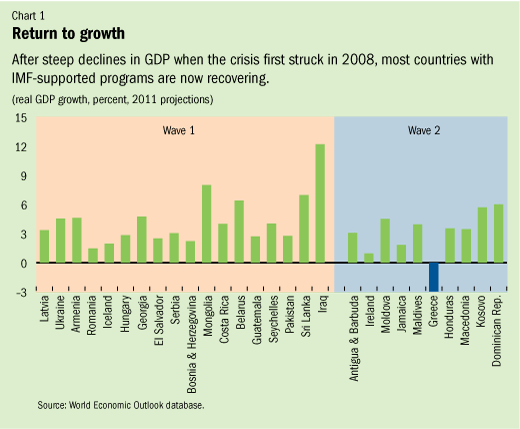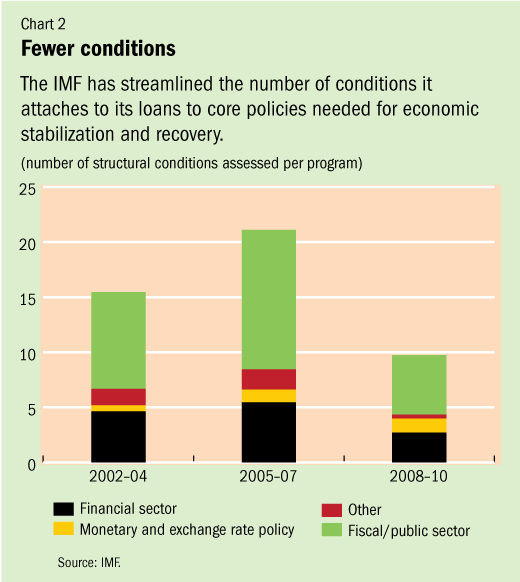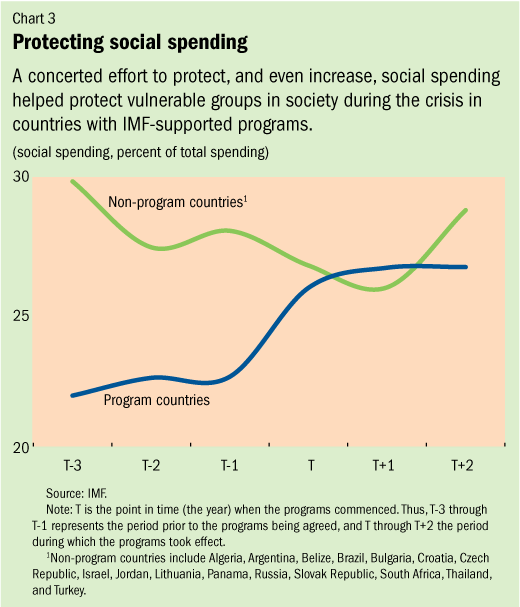
Typical street scene in Santa Ana, El Salvador. (Photo: iStock)
IMF Survey: IMF Support Helping Restore Growth but Key Risks Ahead
April 15, 2011
- IMF financing during global crisis helped ease impact of shock
- Almost all countries with IMF-supported programs seeing return to growth
- Key challenges include restoring competitiveness, reducing debt
A new study finds that countries which sought financial support from the IMF in late 2008, after the failure of the Lehman Brothers investment bank, are experiencing a return to growth.

Factory in Urlati, Romania, where economic recovery is now under way. Romania sought assistance from IMF in May 2009 (photo: Daniel Mihailescu/AFP)
CRISIS ASSESSMENT
The financing provided by the IMF helped countries stabilize their economies at a time when their access to financial markets was seriously curtailed.
But risks remain, the study finds. Many countries need further fiscal consolidation, job creation is lagging behind the recovery, and the political will to implement further difficult reforms is flagging―at a time when more reforms are urgently needed to restore competitiveness.
A second group of countries approached the IMF for financial support in 2010–11. This group of countries, which includes Greece and Ireland, face significant challenges. Further fiscal consolidation to reduce high public debt will be needed for years to come, and reforms to improve the growth potential of the economies will require strong social cohesion and national unity.
The study, conducted by the IMF’s Strategy, Policy, and Review Department, encompassed 29 countries with IMF-supported programs (see box for details).
In an interview, James Roaf, Advisor in the Strategy, Policy, and Review Department, discusses the findings of the study.
The IMF’s response to the crisis
During the 2007–09 global economic crisis, countries ranging from Iceland to Pakistan turned to the IMF for assistance. Since the start of the crisis, the IMF has committed more than $250 billion in loans to its member countries, an all-time high.
Countries in central and eastern Europe were among the first to turn to the IMF for assistance; countries in Latin America and Asia also sought help. Many low-income countries also made use of the IMF’s concessional lending facilities but these cases are not covered by the current study.
As the global crisis abated, a new wave of countries requested IMF support—often because the crisis had exacerbated problems of fiscal sustainability. These included two members of the euro area, Greece and Ireland. Most recently, Portugal has asked for financial assistance.
First wave of countries seeking IMF assistance (2008–mid-2009): Armenia, Belarus, Bosnia & Herzegovina, Costa Rica, El Salvador, Georgia, Guatemala, Hungary, Iceland, Latvia, Mongolia, Pakistan, Romania, Serbia, Seychelles, Sri Lanka, and Ukraine.
Second wave of countries seeking IMF assistance (late 2009–2011): Angola, Antigua and Barbuda, Dominican Republic, Greece, Iraq, Jamaica, Maldives, Moldova, Honduras, Ireland, Kosovo, and Macedonia.
Separately, Flexible Credit Lines (FCL) were granted to Colombia, Mexico, and Poland. The FCL is a precautionary credit line for countries with very strong track records in policy performance.
IMF Survey online: What are the key findings of your study?
Roaf: We found that countries that entered into IMF-supported programs when the crisis hit generally have been successful in stabilizing their economies. Some countries―Latvia in particular―suffered an unprecedented downturn. But generally speaking, large-scale financing from the IMF enabled this group of countries ride out the shock of the crisis and avoid a severe compression of domestic demand and imports. And it’s worth keeping in mind that the contraction would have been much worse in all of these countries, had it not been for the financing from the IMF, the European Union, and other partners.
Growth is now returning in pretty much all the program countries (see Chart 1).
At the same time, adjustment has in many cases not been as wrenching as in the past, in part because of the way the programs have been designed and the large upfront financing provided by the IMF and other partners. We also found good implementation of the policies that were supported by the loan packages.
That said, we see significant challenges ahead. Most importantly, continued action is still needed in a number of countries with protracted problems, including with respect to fiscal sustainability and restoring competitiveness.
IMF Survey online: If we compare with past crises, what are the main differences in the IMF’s approach?
Roaf: In the study, we compare the recent crisis cases with a sample of past crisis cases. Our findings point to less severe fiscal adjustment, less overshooting of exchange rates―the very sharp exchange rate movements that have characterized crises in the past―fewer acute banking sector problems, and less inflation.
Also, policies have been customized to support countries’ own efforts to absorb the economic shock of the crisis (see Chart 2).
IMF Survey online: How does the study measure effectiveness?
Roaf: Effectiveness needs to be measured against the needs of the countries coming to the IMF for support. For many of the countries in the first wave, it was a matter of stabilizing the economy and avoiding excessive adjustment in the face of the shock. By and large, the programs appear to have been effective in achieving that objective.

Other countries have come to the IMF for assistance in addressing more deep-seated structural problems in their economies―especially in the second wave. Some of these countries have very severe fiscal problems, which threaten their ability to continue to access capital markets. They also face the challenge of restoring their economies’ long-term growth potential. We have been flexible in our approach as there is no “one-size-fits-all” set of policies to meet these differing needs.
IMF Survey online: Can you point to particular success stories?
Roaf: Severe problems in the banking sector, such as bank runs, were avoided. The global economic crisis started out as a crisis in the financial sector, which was then imported into many countries.
Some countries, of course, did have major banking problems, such as Iceland and Ireland. But in general, the programs were successful in helping countries avoid full-blown banking sector crises, defying expectations from the early days of the crisis, when people worried about possible banking sector collapses in central and eastern Europe. The European Bank Coordination Initiative played an important role in that region by helping roll over debt and convincing parent banks to maintain their exposure in crisis-hit countries.
"Our new study reveals that social spending as a share of total public spending increased in almost all IMF-supported programs"
Another feature is that we avoided disruptive exchange rate movements, in large measure thanks to the availability of large-scale financing and the credibility conferred by the IMF-supported programs. Large devaluations and exchange rate overshooting have been a hallmark of past crises and can have pernicious effects on households, companies, and banks.

IMF Survey online: The study suggests that some countries are at a critical juncture. What are those countries, and what choices are they facing?
Roaf: A number of countries have come out of the crisis with very high levels of debt. Some of these countries―including Hungary and Greece―already had a lot of debt when they entered the crisis. Other countries, such as Ireland, started out with low public debt, but now face questions about future debt sustainability because of new public debt arising from decisions to rescue their banking systems.
All of these countries face a long adjustment process to restore fiscal sustainability and credibility with the markets. But it is possible to turn the economy around with political and social perseverance, as we have seen in Romania, Latvia, and other crisis-hit countries.
IMF Survey online: Another finding is that the IMF worked harder to protect social spending in this crisis. Can you give us examples of how that has worked in specific countries?
Roaf: In any crisis, it is always the poor who suffer the most. That is why we have worked closely with governments to protect and even increase social spending, to shield the most vulnerable groups in society.
In a previous study we did in 2009, we looked at how social goals had been addressed in IMF-supported programs. We found that there was an effort to protect social spending in all of our programs.
In some cases, social spending was increased. In Costa Rica, for example, the government used available fiscal space to increase spending on education, health, and social protection. As a result, social spending increased by over 3 percentage points of GDP in 2009 and 2010, despite a substantial decline in fiscal revenues.
In other cases, social spending was shielded from overall budget cuts. In Iceland, for example, automatic stabilizers were allowed to operate with few limits in 2009, thereby allowing the country’s extensive social safety net to cushion the blow for the most vulnerable groups in the country.
Our new study reveals that social spending as a share of total public spending increased in almost all IMF-supported programs (see Chart 3). What’s more, it increased the most in the countries with the lowest initial share of social spending.

IMF Survey online: The study also finds that program design was more flexible than in the past. What is meant by flexibility, and can you give us examples?
Roaf: Our study shows that the design of IMF-supported programs was responsive to countries’ specific needs. When conditions changed, the program design changed. Let me give you a couple of examples.
In 2009, no one really appreciated how severe the collapse in output was going to be. The original programs were designed to address modest declines in output. But in the early months, we realized that output was collapsing much faster than we―and others―had expected because of contagion from advanced countries. The programs were quickly adjusted to allow for more government spending, for instance by letting automatic stabilizers work in full. This was especially the case in European programs such as Hungary, Latvia, and Ukraine.
"To allow more time for adjustment, some programs also incorporated measures that had not previously been part of IMF-supported programs, such as capital controls"
To allow more time for adjustment, some programs also incorporated measures that had not previously been part of IMF-supported programs, such as capital controls. Iceland is the most prominent example of countries that used capital controls as part of their IMF-supported programs, but they were also used in some other countries that faced the prospect of disruptive movements of capital.
We also respected countries’ choices about exchange rates. The IMF did not try to impose a particular exchange rate regime. Instead, we advised countries how to design their policies to support the exchange rate system that they were using. Clearly, if a country wishes to maintain a pegged exchange rate, that may mean more fiscal adjustment and downward pressure on wages in order to retain the credibility of such an arrangement. Latvia is an example of a country that opted for strong adjustment while retaining its peg to the euro.
IMF Survey online: How would you define the IMF’s approach to fiscal policy and debt sustainability?
Roaf: The approach we took during the crisis was pragmatic and realistic. In countries where there was fiscal space―where the public debt was low and sustainable―we actually encouraged large fiscal accommodation to counter the effects of the crisis on the economy. In other cases, we advised governments to undertake immediate fiscal consolidation in order to maintain credibility in the markets.
In sum, even though actual fiscal deficits differed a lot between countries, the analysis in the study finds they were set consistently when taking into account the conditions on the ground in the countries requesting financial assistance.
IMF Survey online: What are the main risks facing countries, mainly in central and eastern Europe, whose programs are close to expiring?
Roaf: The big challenge for this group of countries is to avoid reform fatigue and implement the measures needed to restore growth and jobs. Much of the growth in central and eastern Europe prior to the crisis was fueled by unsustainable credit booms. Without credit to drive domestic consumption, countries must now look more to exports as a driver of future growth.
IMF Survey online: Some of the more recent programs, for advanced countries in Europe, face significant challenges. How will the IMF define success in these cases?
Roaf: Success will be to ensure sustainable growth and jobs. But these goals cannot be achieved without improving competitiveness of the economies and restoring sustainability in public finances and credibility in the markets. This will be a long journey.
The joint programs with the European Union and the European Central Bank have set out the road map—including deep-seated structural reforms which are the focus of our European partners in the programs. Credible implementation of programs at the national level and an adequate regional framework at the European level will be key to achieving this.


